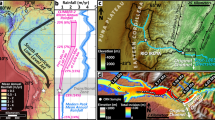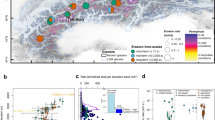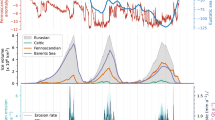Abstract
The hypothesis that abrupt spatial gradients in erosion can cause high strain rates in active orogens has been supported by numerical models that couple erosional processes with lithospheric deformation via gravitational feedbacks1,2,3. Most such models invoke a ‘stream-power’ rule, in which either increased discharge or steeper channel slopes cause higher erosion rates. Spatial variations in precipitation and slopes are therefore predicted to correlate with gradients in both erosion rates and crustal strain. Here we combine observations from a meteorological network across the Greater Himalaya, Nepal, along with estimates of erosion rates at geologic timescales (greater than 100,000 yr) from low-temperature thermochronometry. Across a zone of about 20 km length spanning the Himalayan crest and encompassing a more than fivefold difference in monsoon precipitation, significant spatial variations in geologic erosion rates are not detectable. Decreased rainfall is not balanced by steeper channels. Instead, additional factors that influence river incision rates, such as channel width and sediment concentrations, must compensate for decreasing precipitation. Overall, spatially constant erosion is a response to uniform, upward tectonic transport of Greater Himalayan rock above a crustal ramp.
This is a preview of subscription content, access via your institution
Access options
Subscribe to this journal
Receive 51 print issues and online access
$199.00 per year
only $3.90 per issue
Buy this article
- Purchase on Springer Link
- Instant access to full article PDF
Prices may be subject to local taxes which are calculated during checkout



Similar content being viewed by others
References
Koons, P. O. The topographic evolution of collisional mountain belts: A numerical look at the Southern Alps, New Zealand. Am. J. Sci. 289, 1041–1069 (1989)
Beaumont, C., Jamieson, R. A., Nguyen, M. H. & Lee, B. Himalayan tectonics explained by extrusion of a low-viscosity crustal channel coupled to focused surface denudation. Nature 414, 738–742 (2001)
Willett, S. D. Orogeny and orography: The effects of erosion on the structure of mountain belts. J. Geophys. Res. 104, 28957–28982 (1999)
Hodges, K. V. Tectonics of the Himalaya and southern Tibet from two perspectives. Geol. Soc. Am. Bull. 112, 324–350 (2000)
Tapponnier, P. et al. Oblique stepwise rise and growth of the Tibetan Plateau. Science 394, 1671–1677 (2001)
Burchfiel, B. D. et al. The South Tibetan detachment system, Himalayan orogen: Extension contemporaneous with and parallel to shortening in a collisional mountain belt. Geol. Soc. Am. Spec. Pap. 269, 1–41 (1992)
Harrison, T. M. et al. A late Miocene-Pliocene origin for the central Himalayan inverted metamorphism. Earth Planet. Sci. Lett. 146, E1–E7 (1997)
Catlos, E. J. et al. Geochronologic and thermobarometric constraints on the evolution of the Main Central Thrust, central Nepal Himalaya. J. Geophys. Res. 106, 16177–16204 (2001)
Robinson, D. M. et al. Kinematic model for the Main Central thrust in Nepal. Geology 31, 359–362 (2003)
Hurtado, J. M. Jr, Hodges, K. V. & Whipple, K. Neotectonics of the Thakkhola Graben and implications for Recent activity on the South Tibetan fault system in the central Nepal Himalaya. Geol. Soc. Am. Bull. 113, 222–240 (2001)
Dodson, M. H. in Lectures in Isotope Geology (eds Jaeger, E. & Hunziker, C. J.) 194–202 (Springer, New York, 1979)
Stüwe, K., White, L. & Brown, R. The influence of eroding topography on steady-state isotherms. Application to fission track analysis. Earth Planet. Sci. Lett. 124, 63–74 (1994)
Willett, S. D. & Brandon, M. T. On steady states in mountain belts. Geology 30, 175–178 (2002)
Zeitler, P. K. Cooling history of the NW Himalaya, Pakistan. Tectonics 4, 127–151 (1985)
Tippett, J. M. & Kamp, P. J. J. Fission track analysis of the Late Cenozoic vertical kinematics of continental Pacific crust, South Island, New Zealand. J. Geophys. Res. 98, 16119–16148 (1993)
Porter, S. C. Some geological implication of average Quaternary glacial conditions. Quat. Res. 32, 245–261 (1989)
Ehlers, T. A., Armstrong, P. A. & Chapman, D. S. Normal fault thermal regimes and the interpretation of low-temperature thermochronometers. Phys. Earth Planet. Inter. 126, 179–194 (2001)
Fort, M. B. Glacial extension and catastrophic dynamics along the Annapurna Front, Nepal Himalaya. Göttinger Geogr. Abh. 81, 105–121 (1986)
Duncan, C. C., Klein, A. J., Masek, J. G. & Isacks, B. L. Comparison of Late Pleistocene and modern glacier extents in central Nepal based on digital elevation data and satellite imagery. Quat. Res. 49, 241–254 (1998)
Hallet, B., Hunter, L. & Bogen, J. Rates of erosion and sediment evacuation by glaciers: A review of field data and their implications. Glob. Planet. Change 12, 213–235 (1996)
Hodges, K. V., Parrish, R. R. & Searle, M. P. Tectonic evolution of the central Annapurna Range, Nepalese Himalayas. Tectonics 15, 1264–1291 (1996)
Burbank, D. W. et al. Bedrock incision, rock uplift, and threshold hillslopes in the northwestern Himalaya. Nature 379, 505–510 (1996)
Whipple, K. E., Kirby, E. & Brocklehurst, S. H. Geomorphic limits to climate-induced increases in topographic relief. Nature 401, 39–43 (1999)
Sklar, L. & Dietrich, W. E. Sediment supply, grain size and rock strength controls on rates of river incision into bedrock. Geology 29, 1087–1090 (2001)
Wang, Q. et al. Present-day crustal deformation in China constrained by Global Positioning System measurements. Science 294, 574–577 (2001)
Willett, S. D., Slingerland, R. & Hovius, N. Uplift, shortening, and steady state topography in active mountain belts. Am. J. Sci. 301, 455–485 (2001)
Seeber, L. & Gornitz, V. River profiles along the Himalayan arc as indicators of active tectonics. Tectonophysics 92, 335–367 (1983)
Pandey, M. R., Tandukar, R. P., Avouac, J. P., Lave, J. & Massot, J. P. Interseismic strain accumulation on the Himalayan crustal ramp (Nepal). Geophys. Res. Lett. 22, 751–754 (1995)
Acknowledgements
This work benefited from discussions with K. Hodges, J. Lavé, A. Heimsath, K. Whipple, P. Koons, M. Brandon and T. Ehlers. We thank P. Molnar and C. Beaumont for comments and suggestions. Logistical support from Himalayan Experience and the Nepalese Department of Hydrology and Meteorology is gratefully acknowledged. This work was funded by the NSF Continental Dynamics program and by NASA.
Author information
Authors and Affiliations
Corresponding author
Ethics declarations
Competing interests
The authors declare that they have no competing financial interests.
Rights and permissions
About this article
Cite this article
Burbank, D., Blythe, A., Putkonen, J. et al. Decoupling of erosion and precipitation in the Himalayas. Nature 426, 652–655 (2003). https://doi.org/10.1038/nature02187
Received:
Accepted:
Issue Date:
DOI: https://doi.org/10.1038/nature02187
This article is cited by
-
Elevation-dependent precipitation in the Indian Himalayan Region
Theoretical and Applied Climatology (2024)
-
Medieval demise of a Himalayan giant summit induced by mega-landslide
Nature (2023)
-
Permafrost in the Upper Indus Basin: An active layer dynamics
Journal of Earth System Science (2023)
-
On the solid and liquid precipitation characteristics over the North-West Himalayan region around the turn of the century
Climate Dynamics (2023)
-
Controls on the regional distribution of landslide dams and implications for fluvial landform evolution in Bhutan and its surrounding area
Journal of Mountain Science (2023)
Comments
By submitting a comment you agree to abide by our Terms and Community Guidelines. If you find something abusive or that does not comply with our terms or guidelines please flag it as inappropriate.



